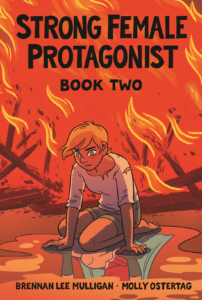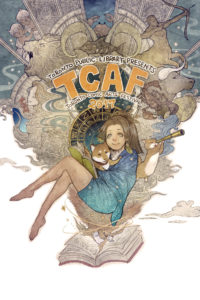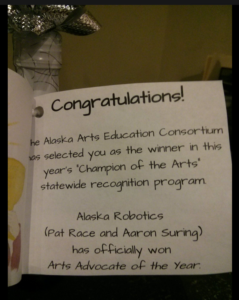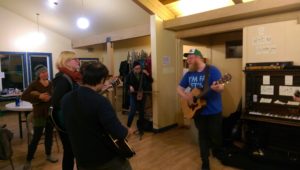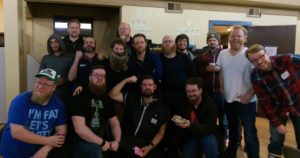
Monday.
Monday was probably the most deep and meaningful day of Comics Camp, but much of it is going to go unremarked upon; this was the day when the assurance that everything was solely for the ears of those present allowed people to open up and discuss things that would not be discussed in public. Plans for future things that may change radically between now and an indefinite then were also tossed around at length. Money was talked about frankly. You weren’t there, my pen was largely still; them’s the breaks.
Certain aspects, however, have had public components, so you get to be pointed in various directions.
Andy McMillan, one of the two Andys behind XOXO Festival, is working on a new project: The Liberty Foundation. Its purpose will be to support independent artists by providing both funding and the tools to turn their artistic practices into sustainable, ongoing businesses; the precise mechanisms by which this will be achieved are still in development, but McMillan will be sharing when he’s ready via Twitter. If you found the Creators For Creators grant of interest, I’d advise you to keep an eye on The Liberty Foundation.
Katie Lane has been mentioned on this page more than once, and she held a Q&A session¹ where anybody with a question about where the law intersects with the arts could get informal advice. Key word there, informal; while Lane is a lawyer, with few exceptions she is not your lawyer and as such was not providing specific legal advice². She did talk generally a good deal about intellectual property, the importance of getting things in writing, and the value of treating legal negotiations as an opportunity to understand the opposing side and come to a place of mutual benefit.
That last bit really struck me; Lane isn’t out to win, she’s out to find a solution that is beneficial to all involved — if only because an agreement that makes everybody happy is less likely to be (expensively!) fought over later. If I lived in Oregon, she’d be my lawyer for everything.
She’s also damn good at explaining things in terms anybody can understand, as when she used a Capri Sun pouch and two water bottles to illustrate the differences between sole proprietorships, LLCs, S-corporations, and C-corporations³. Asked about the one thing to look for in a contract that should be of greatest interest (or ring the loudest bells by its absence), she cited clear terms regarding what rights are assigned and termination of those assignments.
There was ice cream at lunch: spruce-tip in a vanilla base, and blueberry with lemon curd. They were great.
Kate Beaton and Vera Brosgol talked about childrens books. I was most startled by the number of revisions that an oversized book can go through, including the number of versions where King Baby was very much an unlikeable jerk. It takes a lot of work to tread that line where your characters are likable yet interesting. For Brosgol’s case, she noted the value of having characters in your books shout, because when you read to kids they all get to shout, too. She also had her own editorial struggles, especially with respect to word choice; no matter, little kids now know the words samovar and wormhole.
Lucy Bellwood (Adventure Cartoonist!) has been rather open in public about her finances of late (case in point, from earlier this week), and so led a frank discussion on money4. You get the same advice that others shared: there are resources out there to improve financial literacy, like Oh My Dollar and Bad With Money, and services that can help you stay on the right side of money issues, like Tax Jar.
Not being a freelancer and having had the advantage of a decades-long professional career, I got a variety of new perspectives on what fiscal reality is like for those who haven’t followed my particular trajectory. Everybody had something to contribute, though, from the just-starting creators being assured that damn near everything is deductible (including Comics Camp, which is professional development if anything is) to my advice regarding credit cards5. Also: advice regarding crowdfunding, not getting screwed by clients that want to slow-walk paying you, and the value of learning from those that went before you (cf: Spike’s Kickstarter comic, Erika & Matt’s book Numberwangs [NSFW]).
In keeping with the theme, Pat Race and Aaron Suring talked about the process of developing the idea of Comics Camp, and the development of financial resources that allowed them to make it a reality. The amount of effort they went to put this thing on — twice now! — without bankrupting themselves is pretty damn impressive. They should turn it into a case study on financing arts support and take it on the road as a seminar (with a modest, but realistic registration fee; they shouldn’t be bearing all the costs of making the arts community smarter by themselves).
Dinner was followed up by Katie And Ryan’s Very Serious Talk About Being Funny, with everybody’s favourite Canadians; Beaton and North had run the session at Mini-Con on Saturday, but they talked more about their personal philosophies of humour. Beaton credits writing laugh-chuckles as making her more empathetic, while acknowledging that finding something that makes her laugh prompts her to immediately destroy that joy by picking it apart like a gross sponge. North noted that comedy is one of the two easiest genres to write in, because if you’re doing it right there’s an immediate physical reaction6; you can’t make others laugh if you don’t first make yourself laugh.
Then they made us do worksheets. New Yorker cartoons with the captions erased (it would be cheating to fill them all in with Christ, what an asshole), comic strips with the last panel missing (including a series of Cathy strips where you were not allowed to simply write ACK!). It was a tough exercise, and even tougher to come up with something original; there were huge thematic and wording overlaps in the New Yorker captions among those present.
There was a photo op for all the self-identified bearded Campers and short presentations hosted by McMillan — titled Presentations By People Who Didn’t Have Presentations Talky People Shut Up Time — for any topics not covered elsewhen at Camp. This included a fast five minutes from Molly Lewis on Bullet Journaling that I suspect has led more than one Camper down a hole of special pens and washi tape7.
During that time I was tapped on the shoulder by Seth Boyer who said he’d heard I mix good cocktails; I gave him something I’d been working on that weekend called the Aurora Georgealis and it prompted a spontaneous Wow! of appreciation that made me feel like I belonged among the artists and creators.
For those of you wanting to make your own, it’s derived from your basic sour:
1 oz liquor
1 oz citrus
1 oz simple syrup
Shake, strain, garnish as desired.
By choosing an appropriate citrus to match the spirit, you have almost infinite flexibility. The liquor I chose was an aged dark rum; earlier in the weekend the citrus was blood orange, but tonight I was using the last of the breakfast juice, which was a combo of orange, peach, and mango. Because it was a bit sweet, I cut back the juice to 3/4 oz and added several squeezes of lime. The simple syrup had been previously dressed with two airline bottles of white rum, lime juice, lime zest, and vanilla, making an impromptu falernum. The name was inspired by Georgina Hayns, whose enthusiasm for the borealis was matched only by her enthusiasm for helping me perfect the recipe.
And then, before everybody slipped away, the music started. I realize that I’m over 1500 words in already and so I’m going to talk about the impromptu singalong and the musicians of Camp in their own post. They deserve it.
Photos
Not so many today; turns out that sitting around talking about serious topics isn’t that interesting, visually speaking.
_______________
¹ Titled Lightning Lawyer! You have to sing it, though, for full effect: Light-ning LAW-yer! As a matter of fact, if you’re ever around Lane in person and her name is said out loud, you are obligated to sing it.
² Specific legal advice is not offered in public, and you pay for it.
³ I’ve made my living for a quarter-century by teaching technical topics, mostly by means of creative analogy. This was the best I’ve ever seen.
4 Which she introduced (with characteristic enthusiasm) as Money! You want it! What is it? How do you get it? And how can you keep it?
5 Three rules: 1. Always pay them off every month; 2. Never accept an offer that’s blind-mailed to you; 3. Don’t pay for the privilege of carrying a card.
That last one I amended in conversation with fellow camper Tara, who was wondering about the Alaska Air miles-earning credit card, but which carries an annual fee. If you can keep to Rule 1 and you get enough miles or other benefits (like free checked bags) to offset the fee, that’s fine. I was thinking more along the lines of the Amex Platinum offer I got in the mail this week, which offers me the exclusive prestige of Platinum (ugh) for the trivial cost of $450 per year. Screw that.
And, full disclaimer, under the assumption that I’m going to any future Comics Camp that will have me, I went and looked at the Alaska Air credit card and figured that it makes sense financially for me (especially after I discovered they fly nonstop from Newark to San Diego, with First Class on Alaska only about $200 more than steerage on United).
6 The other is erotica. Ladies.
7 Don’t ask.


